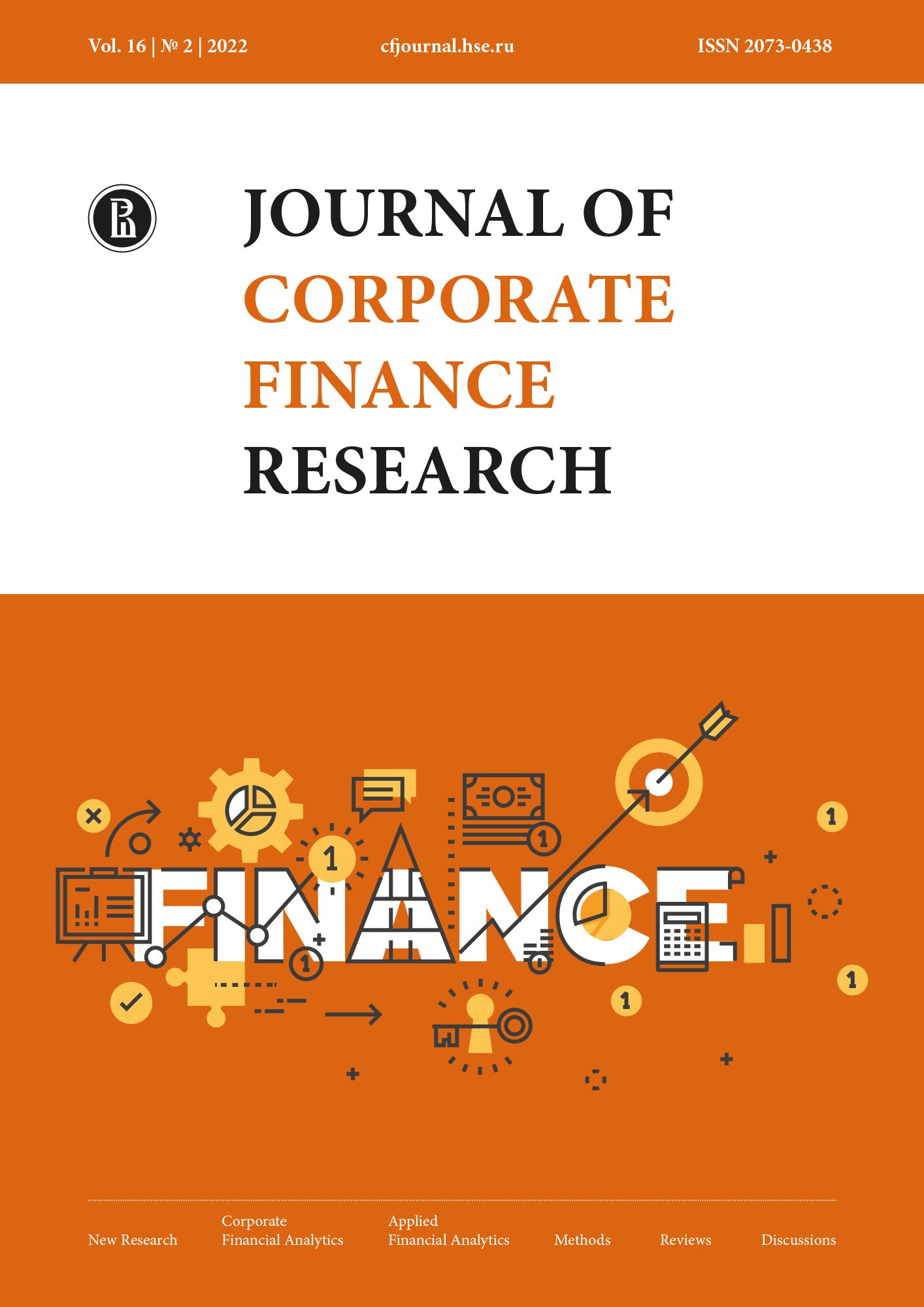How Do External Shocks Affect the Economic Efficiency of Companies with Foreign Direct Investment?
Abstract
The purpose of this study is to assess the effectiveness of export and import activities of domestic companies with foreign direct investment during the external shocks. The relevance of the research is due to the fact that the impact of side effects of FDI on domestic companies and economic uncertainty after the sanctions and the outbreak of the pandemic was ambiguous. The empirical base contains about 170,000 observations on 18,799 operating companies with a foreign capital share of at least 10% for the period from 2012 to 2020, obtained from the Ruslana database - Bureau Van Dijk. For the purposes of the study, the companies are grouped by the industry and their roles in international trade. Efficiency assessment is measured by using the data envelopment analysis (DEA), taking into account the spillover effects from foreign direct investment. The results of the study confirm that firms that trade in both directions have better performance. Next come companies focused only on export or import. Companies that are not involved in international trade are the least efficient (hypothesis 1). Industries that benefit from FDI inflows include more capital-intensive sectors (hypothesis 2). External shocks have a negative impact on the efficiency of companies with FDI (hypothesis 3). This understanding has important implications for long-term economic growth and the recovery of the Russian economy in the current external shocks.
Downloads
References
Customs statistics of foreign trade documents. Federal Customs Service of Russia. URL: http://stat.customs.gov.ru/documents (accessed on 01.04.2022). (In Russ.).
Fedorova E.A., Nikolaev A.E., Shirokova Yu.S., Fedorov F.Yu. Export and import activities of Russian companies with FDI in the context of sanctions. Finansovyi zhurnal = Financial Journal. 2019;(3):75-90. (In Russ.). DOI: 10.31107/2075-1990-2019-3-75-90 DOI: https://doi.org/10.31107/2075-1990-2019-3-75-90
External Sector statistics. Bank of Russia. URL: https://cbr.ru/statistics/macro_itm/svs/ (accessed on 01.04.2022). (In Russ.).
European investment attractiveness survey 2020: Russia. Moscow: Ernst & Young; 2021. 20 p. URL: https://assets.ey.com/content/dam/ey-sites/ey-com/ru_ru/news/2021/06/european-attractiveness-survey-2021-russia-ver-2.pdf (accessed on 01.04.2022). (In Russ.).
Sharma C., Mishra R.K. International trade and performance of firms: Unraveling export, import and productivity puzzle. The Quarterly Review of Economics and Finance. 2015;(57):61-74. https://doi.org/10.1016/j.qref.2015.02.001 DOI: https://doi.org/10.1016/j.qref.2015.02.001
Kasahara H., Lapham B. Productivity and the decision to import and export: Theory and evidence. Journal of International Economics. 2013;89(2):297-316. https://doi.org/10.1016/j.jinteco.2012.08.005 DOI: https://doi.org/10.1016/j.jinteco.2012.08.005
Muûls M., Pisu M. Imports and exports at the level of the firm: Evidence from Belgium. The World Economy. 2009;32(5):692–734. https://dx.doi.org/10.1111/j.1467-9701.2009.01172.x DOI: https://doi.org/10.1111/j.1467-9701.2009.01172.x
Ran J., Voon J.P., Li G. How does FDI affect China? Evidence from industries and provinces. Journal of Comparative Economics. 2007;35(4):774-799. https://doi.org/10.1016/j.jce.2007.05.001 DOI: https://doi.org/10.1016/j.jce.2007.05.001
Kuznetsov D.E. Analysis of relation between capital intensive sectors and direct foreign investments. Ekonomicheskoe razvitie Rossii = Russian Economic Developments. 2019;26(11):23-30. (In Russ.).
Antràs P., Yeaple S.R. Multinational firms and the structure of international trade. In: Gopinath G., Helpman E., Rogoff K., eds. Handbook of international economics. Amsterdam: Elsevier B.V.; 2014:4:55-130. https://doi.org/10.1016/B978-0-444-54314-1.00002-1 DOI: https://doi.org/10.1016/B978-0-444-54314-1.00002-1
Zapadnyuk E.A. The impact of global financial shocks on the world economy. Belarus' i mirovye ekonomicheskie processy : sbornik nauchnyh statej= Belarus and world economic processes : collection of scientific articles. Minsk; 2015;(12):189-197. URL: https://elib.bsu.by/bitstream/123456789/148928/1/189-197.pdf (In Russ.).
Wong Z., Chen A., Peng D., Kong Q. Does technology-seeking OFDI improve the productivity of Chinese firms under the COVID-19 pandemic? Global Finance Journal. 2022;51:100675. https://doi.org/10.1016/j.gfj.2021.100675 DOI: https://doi.org/10.1016/j.gfj.2021.100675
Zarbi S., Shin S.-H., Shin Y.-J. An analysis by window DEA on the influence of international sanction to the efficiency of Iranian container ports. The Asian Journal of Shipping and Logistics. 2019;35(4):163-171. https://doi.org/10.1016/j.ajsl.2019.12.003 DOI: https://doi.org/10.1016/j.ajsl.2019.12.003
Vujanović N., Stojčić N., Hashi I. FDI spillovers and firm productivity during crisis: Empirical evidence from transition economies. Economic Systems. 2021;45(2):100865. https://doi.org/10.1016/j.ecosys.2021.100865 DOI: https://doi.org/10.1016/j.ecosys.2021.100865
Bykova A., Jardon C.M. Lean against the wind: The moderation effect of foreign investments during the economic recession in Russia. Journal of Economics and Business. 2017;93:1-14. https://doi.org/10.1016/j.jeconbus.2017.07.001 DOI: https://doi.org/10.1016/j.jeconbus.2017.07.001
Fedorova E.A., Nikolaev A.E., Rashchupkina A.A., Fedorov F.Yu. Evaluation of the effectiveness of foreign direct investment impact on the activities of domestic companies during the sanctions period: Industry aspect. Vestnik Moskovskogo universiteta. Seriya 6: Ekonomika = Moscow University Economic Bulletin. 2020;(5):158-181. (In Russ.). DOI: https://doi.org/10.38050/01300105202058
Charnes A., Cooper W.W., Rhodes E. Measuring the efficiency of decision making units. European Journal of Operational Research;1978:(2):429–444. https://doi.org/10.1016/0377-2217 (78)90138-8 DOI: https://doi.org/10.1016/0377-2217(78)90138-8
Mirmozaffari M., Yazdani R., Shadkam E. et al. An integrated artificial intelligence model for efficiency assessment in pharmaceutical companies during the COVID-19 pandemic. Sustainable Operations and Computers. 2022;3:156-167. https://doi.org/10.1016/j.susoc.2022.01.003 DOI: https://doi.org/10.1016/j.susoc.2022.01.003
Rath B.N. Productivity growth and efficiency change: Comparing manufacturing- and service-based firms in India. Economic Modelling. 2018;70:447-457. https://doi.org/10.1016/j.econmod.2017.08.024 DOI: https://doi.org/10.1016/j.econmod.2017.08.024
Fedorova E.A., Tkachenko A.A., Fedorov F. Yu, Mazalov E.S. Evaluation of the technical efficiency of companies of the military-industrial complex. Korporativnye Finansy = Journal of Corporate Research.2015;4(36):140-149. https://doi.org/10.17323/j.jcfr.2073-0438.9.4.2015.138-148 DOI: https://doi.org/10.17323/j.jcfr.2073-0438.9.4.2015.138-148
Lin P., Liu Z., Zhang Y. Do Chinese domestic firms benefit from FDI inflow? Evidence of horizontal and vertical spillovers. China Economic Review. 2009;20(4):677-691. https://doi.org/10.1016/j.chieco.2009.05.010 DOI: https://doi.org/10.1016/j.chieco.2009.05.010
Dranko O.I. The capital requirements of the activity types of the Russian economy. Audit i finansovyi analiz = Audit and Financial Analysis. 2015;(3):67-70. URL: https://www.auditfin.com/fin/2015/3/fin_2015_31_rus_03_02.pdf (In Russ.).
Copyright (c) 2022 National Research University Higher School of Economics

This work is licensed under a Creative Commons Attribution-NonCommercial-NoDerivatives 4.0 International License.

